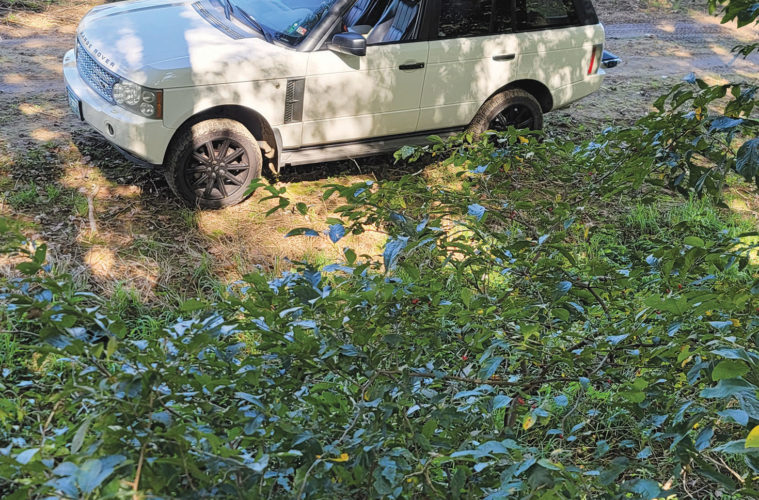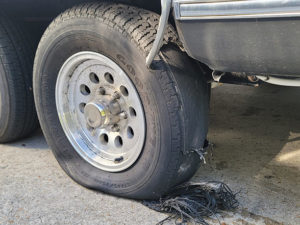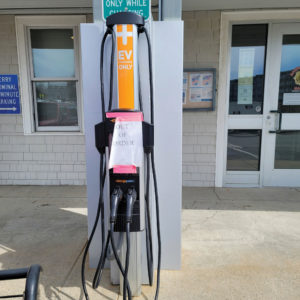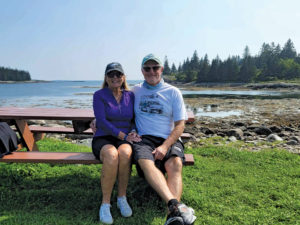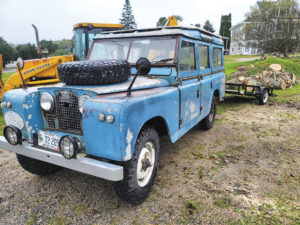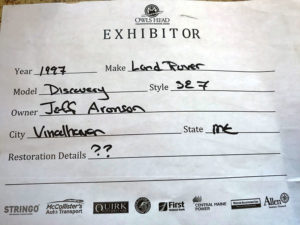I just returned from ROAV’s Mid Atlantic Rally in Arvonia, VA, where I enjoyed sitting behind the steering wheel, this time in a Range Rover L322 Supercharged. This ride, a most unusual luxury for me, came courtesy of Nancy and Mike McCaig, who loaned it to Rovers North’s Gene Schubert and me as transportation for the long weekend.
The odometer displayed a number exceeding 110,000 miles, but only a few scuff marks on the interior bore witness to the L322’s mileage. No disconcerting sounds or hesitancy emanated from the engine. Occasionally, a fault message would appear on the screen below the speedometer and would then disappear. I chose to ignore these little blips. A Range Rover would never have a genuine fault, and besides, it wasn’t my vehicle. Like a misbehaving young relative, you will hand them back to their parents in due course.
I pointed out the one reading that concerned me to Mike McCaig. One gauge had only two letters on it, “F” and “E.” As an expert driver, I checked all the gauges when starting up the Range Rover; that particular gauge read “F.” After a couple of days of testing out the supercharger, I noticed that the needle moved left towards “E.” I alerted Mike of this and asked him to fix it for us. He noted that in the past, his daughter Sarah McCaig had tried the same tactic — unsuccessfully — and suggested that opening the small door on the passenger’s side rear, unscrewing the cap and pouring gasoline into the spout would fix the problem. Mike, you were right! The needle moved back to “F.”
This third-generation Range Rover had not gone on an aluminum diet; at 5,533 pounds empty, it felt hefty yet tracked wonderfully on the twisty roads. I tried to look as though I owned this loaner, as if it demonstrated my status, but as I passed each speed trap in the small towns between Charlottesville and Arvonia, every deputy eyed me suspiciously. On the other hand, when Gene took the wheel, he evinced a level of aristocratic bearing and savoir faire that seemingly convinced every officer that pulling him over would just be crass and unseemly. As a Land Rover Experience instructor, he drove quite smoothly, on-road and off. He also took the opportunity to offer me corrective advice when the Range Rover began slipping on very muddy trails. Of course, I didn’t really need the advice, but when I followed it, the vehicle stopped sliding around. Hmmm…
Before returning it to the McCaigs, we took the L322 to a car-wash to empty out our guy trash and remove the inevitable mud from the lower sides of the Range Rover. Several large signs, reading “NO MUD,” “No washing of truck beds,” “No washing of engines,” greeted us as we pulled into the self-serve car wash. Gene concluded that the globs of stuff affixed to the Range Rover did not constitute “mud,” but rather “dirt,” and therefore, we could continue with the wash.
The McCaig’s contributions to the Land Rover community merit our appreciation, but they’re too modest to entertain that notion. Mike’s wizardry with an excavator helped create the event’s RTV course. As a family, they’ve been stalwart supporters and leaders of the Rover Owners of Virginia. More recently, Mike’s role in reviving the Association of North American Land Rover Clubs (ANARC) and serving as president during the wildly successful Diamond Jubilee last June, deserves continued recognition. Nancy worked behind the scenes with the event’s honorees; Sarah McCaig took on the responsibility that no one wanted of managing the banquets and dinners.
As a kid, I had a set of Lionel electric trains. Keeping them running proved a challenge, not because of any problem with the engines or train cars, but due to my ineptitude with electronics. Routinely, I would blow a fuse or trip a circuit breaker because I either forget whether (+) meant positive or negative or would hook up an accessory wrong. My overall lack of proficiency with electronics continues to this day and does not bode well for my future with electric vehicles.
My most recent electrical experience came when riding with Bob Steele, Bon Air, VA. He had a tire fail at speed on his Airstream; the flapping tread scalped the wiring harness, making multi-strand wiring resemble fiberglass insulation. Nothing electrical worked on the trailer. Lawrence Michelon, Norfolk, VA, a “Senior Engineer for Systems Design and Integration” (whatever that means) on naval vessels, determined the type and gauge of wiring required for a field repair and instructed Bob to “buy these parts.” Sent on a quest, Gene Schubert of Rovers North and I headed to an auto parts store in search of the correct gauge and type of wire. There, a parts expert explained, “You need to go to an auto sound system/ home theater store. These new sound systems handle thousands of amps,” he said. “They’ll have the right wires.” (The last electrical component I added to my Series IIA, a CB radio, sent smoke pouring from the engine bay.) The thought of thousands of amps coursing through my IIA’s electrical wiring makes me hug my fire extinguisher.
JLR has stated that “By 2030, all ‘nameplates’ [Arghh! There’s that ‘House of Brands’ again –ed.] will offer pure electric options that are expected to account for 60% of our retail sales.” Richard Truett of Automotive News predicted that the Range Rover will have an electric version for late 2024, as will the Range Rover Sport. Since the Range Rover Velar shares the same EMA platform as the Discovery and Evoque, Truett believes that the three “nameplates” will have electric versions in 2025. That leaves the Defender, which might see an electric version in 2025 – although gasoline and hybrid engines will continue in production. Who knows? I might have to confront owning an electric vehicle one day.
The world market for electric automobiles increases monthly. The EU has set a goal that by 2035, all new vehicles sold in their countries will have “zero-emission power plants,” and that has come to mean electric vehicles. California’s emissions standards have been adopted by 17 other states; collectively, they account for about 40% of new car sales. By 2035, California and its supporting states have mandated zero-emission cars and light trucks; ICEs [internal combustion engine vehicles –ed.] already registered will be permitted, but there’s consideration of additional incentives to reduce the numbers.
Electric vehicle adoption faces another significant challenge; according to Automotive News, “There are nowhere near enough certified technicians to fix all the broken chargers: “Nearly 4,000 public charging stations with more than 7,000 ports were out of service as of early October, according to the U.S. Department of Energy. Thats an outage rate of more than 6 percent.”
I live on a Maine island with one gas station, operated by our Fisherman’s Co-Op. When no one was available to pump gas one weekend, we simply had to do without. We also have but two electricians; neither has training on EV chargers. The transition could prove — interesting — in the future.
“When you come to Maine, do visit me on the island!” I’ve said this many times, comforted by the reality that the island requires a 1.5-hour boat ride each way on a ferry that can make the grossest inner city bus look inviting. This summer, my complacency was shattered by three sets of delightful visitors.
Ken Jagolta of Surfside 4X4, Pompano Beach, FL, and his wife Deb found themselves at a resort across the bay from this island, and happily, shared their time with me. Ken runs what he calls a “Defender Adoption Agency,” and I’m sure that after bouncing around the island in my 109”, he wished he could adopt mine and give it the love it deserves.
Dan and Laurie Hawthorne, Midlothian, VA, spent their honeymoon in Maine and included an island visit and a stop in Scott Preston’s Mount Desert Island. Laurie wrote that “It was a spectacular start to the rest of our lives!” Dan participated in the MAR and affirmed they had a great time during their first visit to Maine.
Fifty years ago, Bruce and Gertrude “Jimmy” McWilliams ran British Leyland’s North American subsidiary. One of their more painful decisions came when Land Rover realized it could not make the Series III meet US emissions and safety regulations, so in 1974, they stopped importation of the marque; Land Rover would not return to the North American market until 1989, in the form of Range Rover North America.
Their son, Richard McWilliams, moved to Yarmouth, ME. This summer, his wife, Sandy Wachholz and her friends, Deb Fredericks, Stillwater, MN, and Gina Wimmer, St, Charles, MN, took a day to visit this island and enjoy (I hope) touring the sights in my ’67 109” SW. As a thank you, Richard sent me a Land Rover pin worn by his father back in the day. It has a place of honor on my Land Rover artifact table!
In October, I drove “Gilroy,” my ’97 Discovery I SE7, to the annual Owls Head Transportation “Foreign Car Day.” The staff handed me a windshield card to complete, which asked for “Restoration Details.” All I could think of was, “Filled it with Gas,” but here’s what I wrote instead.
